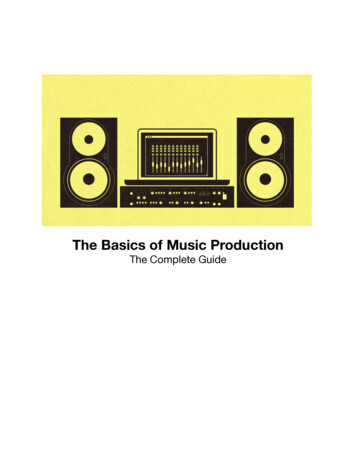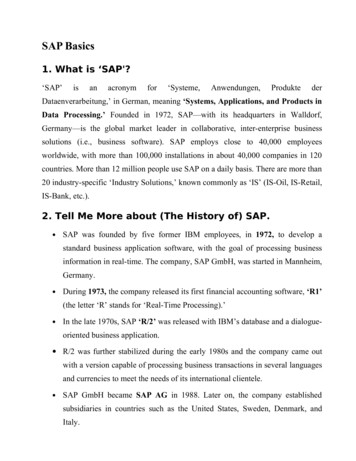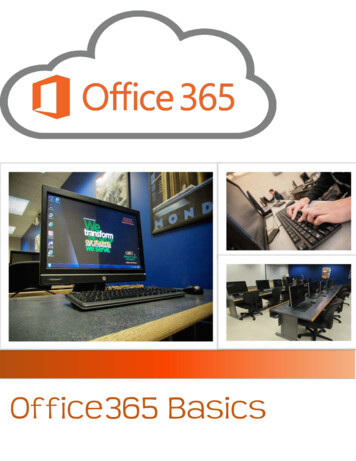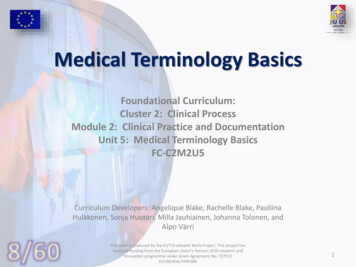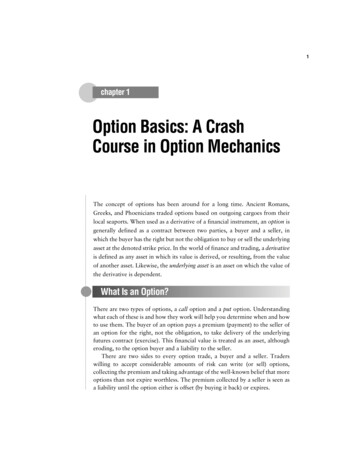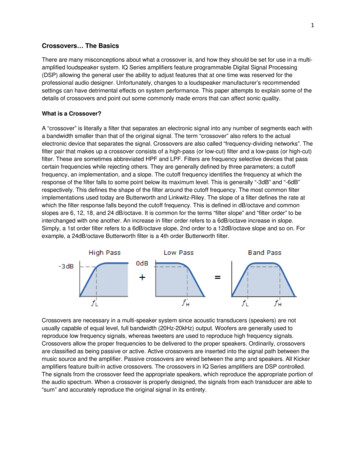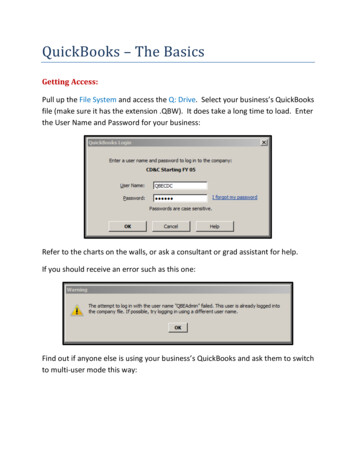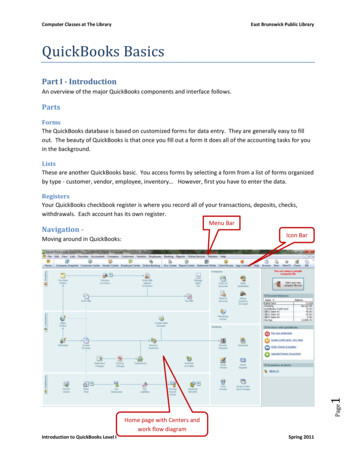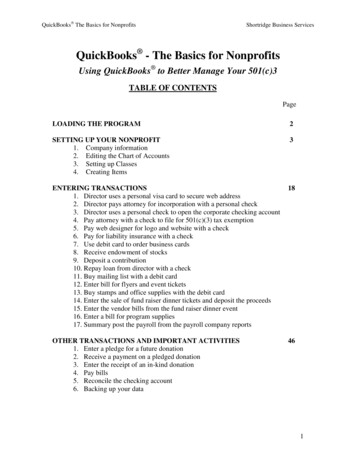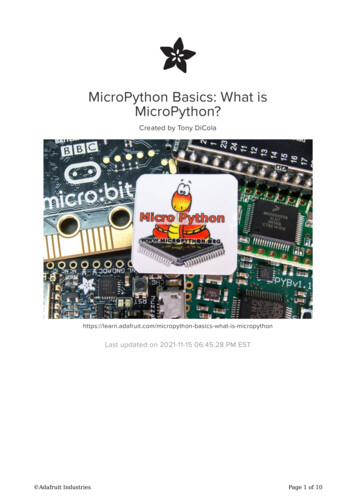
Transcription
MicroPython Basics: What isMicroPython?Created by Tony s-what-is-micropythonLast updated on 2021-11-15 06:45:28 PM EST Adafruit IndustriesPage 1 of 10
Table of ContentsOverview Adafruit Industries3Page 2 of 10
OverviewThe information in this guide is no longer supported and may not work. We areonly supporting CircuitPython on our boards. For more information about usingCircuitPython, check out Welcome to CircuitPython: nThis guide explains what is the MicroPython programming language (https://adafru.it/pF5), why you might want to use it for hardware projects, and where to find moreinformation on MicroPython. If you're familiar with Arduino (https://adafru.it/lDg) you'lllearn how MicroPython compares to it and why you might want to explore usingMicroPython in place of Arduino. Don't worry though if you're totally new to hardwareand programming MicroPython is a great place to start learning!In addition this guide also explores CircuitPython (https://adafru.it/tB7) which isAdafruit's open source derivative of MicroPython with a focus on being simple forbeginners to get started with electronics. Read below to learn more about thedifferences between CircuitPython and MicroPython. Both use the same Pythonprogramming language and have similar features--almost anything you can do inMicroPython can be done in CircuitPython (and more!). Adafruit IndustriesPage 3 of 10
What is MicroPython?MicroPython (https://adafru.it/pOb) is a tiny open source Python programminglanguage (https://adafru.it/deW) interpretor that runs on small embeddeddevelopment boards. With MicroPython you can write clean and simple Pythoncode to control hardware instead of having to use complex low-level languageslike C or C (what Arduino uses for programming).The simplicity of the Python programming language makes MicroPython anexcellent choice for beginners who are new to programming and hardware.However MicroPython is also quite full-featured and supports most of Python'ssyntax so even seasoned Python veterans will find MicroPython familiar and fun touse.Beyond its ease of use MicroPython has some unique features that set it apart fromother embedded systems: Interactive REPL, or read-evaluate-print loop. This allows you to connect to aboard and have it execute code without any need for compiling oruploading--perfect for quickly learning and experimenting with hardware! Extensive software library. Like the normal Python programming langaugeMicroPython is 'batteries included' and has libraries built in to support manytasks. For example parsing JSON data from a web service, searching textwith a regular expression, or even doing network socket programming is easywith built-in libraries for MicroPython. Extensibility. For advanced users MicroPython is extensible with low-level C/C functions so you can mix expressive high-level MicroPython code withfaster low-level code when you need it. Adafruit IndustriesPage 4 of 10
What is CircuitPython? How does it relate to MicroPython?CircuitPython (https://adafru.it/tB7) is Adafruit's open source derivative ofMicroPython. This version of MicroPython was created to add support for easilygetting started with electronics using boards like Circuit Playground Express,Trinket M0, Gemma M0, and more. Check out the CircuitPythondocumentation (https://adafru.it/yDd) for more details about it, including a list ofdifferences between CircuitPython and MicroPython (https://adafru.it/yDe).In almost all cases you can do the same things with both CircuitPython andMicroPython. CircuitPython has slightly different and simpler APIs for accessingsome hardware components like digital I/O, I2C, SPI, etc. However the core Pythonlanguage support is the same between CircuitPython and MicroPython. Unless aguide or project notes otherwise you can use the same code betweenCircuitPython and MicroPython and vice-versa.What can MicroPython do?Almost anything you can imagine! Just like an Arduino board MicroPython cancontrol hardware and connected devices. You can control GPIO pins to blink lights,read switches, and more. You can drive PWM outputs for servos, LEDs, etc. or readanalog sensors with an analog to digital converter. Talking to I2C or SPI devices iseasy too, and you'll even find network & WiFi support on some boards.MicroPython even has libraries for controling other hardware like NeoPixels andLED strips, tiny OLED displays, and more.In short, MicroPython can do a lot!For some examples of what MicroPython can do check out the following: Video overview of MicroPython Pyboard (https://adafru.it/pF6) Video overview of MicroPython on ESP8266 (https://adafru.it/pF7) Kickstarter campaign video for MicroPython on ESP8266 (https://adafru.it/pF8) Video demo of dice game in MicroPython on the bbc:microbit (https://adafru.it/pF9) Play with a live MicroPython Pyboard over the internet (https://adafru.it/pFa)What can't MicroPython do?There are very few limitations with MicroPython, almost anything an Arduino cando can also be done by a MicroPython board. However one thing to realize is thatMicroPython code isn't as fast and might use a little more memory compared to Adafruit IndustriesPage 5 of 10
similar Arduino or other low-level C/C -based code. Usually this doesn't mattersince the speed and memory differences are small and don't impact most normaluses.However be aware that code which has tight timing or performancerequirements might not work in MicroPython. For example 'bit banging' a fastserial protocol entirely in MicroPython might not be the best idea. However thereare ways to mix both MicroPython and low-level C/C code so you can have thebest of both worlds--your main logic in clean and easy to understand MicroPythoncode, and performance critical parts written in faster low-level code.The MicroPython langauge implements most of the core Python 3 language,however MicroPython can't implement the entire Python 3 standard library. Pythonis known for having an extensive standard library, but trying to squeeze such a biglibrary onto tiny boards with just kilobytes of memory isn't possible. MicroPythoninstead implements smallers versions of some Python standard libraries to give youa great development experience.How does MicroPython/CircuitPython compare toArduino?There are a couple important differences between Arduino and MicroPython. Thefirst is that Arduino is an entire 'ecosystem' with the Arduino IDE (i.e. the desktopapplication you use to write and upload sketches), the Arduino programminglanguage (based on C/C ), and Arduino hardware like the Arduino Uno R3 board.MicroPython is only a programming language interpreter and does not include aneditor. Some MicroPython boards support a web-based code prompt/editor, butwith most MicroPython boards you'll write code in your desired text editor and thenuse small tools to upload and run the code on a board.If you're coming to MicroPython or CircuitPython from a language that has a fullIDE/editing environment like Arduino you might want some tips on how toconfigure and use a text editor and other tools for MicroPython/CircuitPythondevelopment. See these videos below for a deep dive into setting and usingMicroPython/CircuitPython on different platforms: CircuitPython on ChromeOS (https://adafru.it/yDf) CircuitPython on Windows (https://adafru.it/yDg) CircuitPython on macOS (https://adafru.it/yDh)The second important difference is that the MicroPython language is interpretedinstead of being compiled into code the CPU can run directly like with the Arduino Adafruit IndustriesPage 6 of 10
programming language. Interpreted means when MicroPython code runs it has todo a little more work to convert from MicroPython code to instructions the CPUunderstands.A major advantage of interpreted code is that it can be much cleaner and simplercompared to languages that compile directly to CPU instructions. You can evenwrite and run interpreted code like MicroPython directly on a board without anycompiling or uploading--something that's impossible with Arduino!One disadvantage of interpreted code and MicroPython vs. Arduino is that there'sless performance and sometimes more memory usage when interpreting code. Afunction or sketch written in Arduino will run as fast as possible on a board's CPUwhereas similar code in MicroPython will be a little slower because it has tointerpret every instruction and convert it to CPU code. In practice this performancehit is rarely an issue for the kinds of projects you might create with Arduino. If youdo run into performance or memory problems MicroPython allows you to writecode in C/C or even the board's native CPU assembly instructions for maximumperfomance.Ultimately there's no simple answer for the choice between MicroPython andArduino. Each has strengths and weaknesses that should be considered for yourown projects. Don't be afraid to try MicroPython--for some boards like theESP8266 you can actually use either MicroPython or Arduino and pick the best onefor your needs.What hardware supports MicroPython?Be sure to check the MicroPython website (https://adafru.it/pF5) to see the latestinformation on supported boards. As of August 2016 these boards supportMicroPython in various ways: pyboard (https://adafru.it/pFb) This is the first MicroPython board and has very complete support forthe language and hardware peripherals. This board comes to you withMicroPython running on it so you can get started using it immediatelywithout any setup. Check out the pyboard documentation (https://adafru.it/pFc) for more details on its capabilities. ESP8266 (https://adafru.it/n6A) MicroPython support for the popular ESP8266 WiFi microcontroller isexcellent. With MicroPython on ESP8266 you can access peripheralslike GPIO, ADC, PWM, and I2C/SPI devices. In addition WiFi & internetaccess is available and well supported. There's even a web-basedREPL that allows you to run MicroPython code on the ESP8266 through Adafruit IndustriesPage 7 of 10
your web browser! Check out the ESP8266 MicroPythondocumentation (https://adafru.it/pFd) and the MicroPython ESP8266FAQ forum page (https://adafru.it/pFe) for more information. If you'relooking for an inexpensive and easy board to start with MicroPython theESP8266 is a great option. SAMD21-based Boards (https://adafru.it/sac) Atmel SAMD21-based boards like the Feather M0 and Arduino Zero canuse CircuitPython, Adafruit's open source derivative of MicroPython.See the Metro M0 Express guide (https://adafru.it/xAX) for moreinformation on using CircuitPython with these boards. WiPy (https://adafru.it/pFf) The WiPy is another MicroPython board with WiFi and great support.Pycom (https://adafru.it/pFg) is the company behind the WiPy board andthey provide a nice integrated development environment to load andrun MicroPython code on their boards. Be sure to see the WiPy pageon Pycom's website (https://adafru.it/pFh) for more information about theboard's capabilities, in particular note the board currently doesn'tsupport floating point calculations. BBC micro:bit (https://adafru.it/pFi) The BBC micro:bit has great support for MicroPython and a very nice setof tools to write and upload code. With MicroPython on themicro:bit you can access the board's onboard peripherals including itsLEDs, accelerometer, GPIO, radio, and more. Check out the officialmicro:bit MicroPython documentation (https://adafru.it/pFj) for moredetails. Teensy 3.x (https://adafru.it/j7a) The Teensy 3.x series of microcontrollers have an early port ofMicroPython available (https://adafru.it/pFk). Be aware you might needto be familiar with building firmware and compiling code to use this portas there aren't pre-made images available. This port of MicroPython isalso a bit less mature compared to other boards but can still accessbasic peripherals like GPIO on the board. If you're looking at usingMicroPython on a Teensy you'll want to check out the Teensyforums (https://adafru.it/pFk) to learn more about what's possible in thecurrent port.See the MicroPython GitHub repository (https://adafru.it/fa3) for more informationon other supported boards & platforms. Adafruit IndustriesPage 8 of 10
Do I need to be a Python expert to use MicroPython?Absolutely not! MicroPython implements most of the Python 3 core language andas such it can be as simple or complex as you need. As a Python beginner you'llfeel right at home accessing MicroPython's REPL and experimenting with code.Python is praised for having a clean and easy to learn syntax that's great forbeginners.If you're new to Python it will help to get familiar with the basics of Pythonprogramming on your computer. Some good free resources for learning Pythonare: Learning Python resources from the Hitchhiker's Guide to Python (https://adafru.it/fQG) Learn Python The Hard Way (https://adafru.it/pFl)If you're more experienced with Python you'll be amazed at just how much ofPython's expressive power is in MicroPython. Advanced concepts like functionaland dynamic programming are all possible with MicroPython. You can even diveinto the MicroPython codebase and start extending it with new functions, libraries,and more.Where can I learn more about MicroPython?Check out the following resources to learn more about MicroPython and how touse it with specific boards: MicroPython homepage (https://adafru.it/pF5) MicroPython pyboard documentation (https://adafru.it/pFc) MicroPython ESP8266 documentation (https://adafru.it/pFm) and MicroPythonESP8266 FAQ forum page (https://adafru.it/pFe) MicroPython BBC micro:bit documentation (https://adafru.it/pFj) MicroPython WiPy documentation (https://adafru.it/pFn) MicroPython Developer Wiki (https://adafru.it/pFo) Differences between MicroPython and standard desktop Python (https://adafru.it/fai)How do I get help with MicroPython?There's a growing community of MicroPython users who might be able to help youif you have questions or issues: MicroPython forums (https://adafru.it/pFp) Adafruit IndustriesPage 9 of 10
MicroPython GitHub home (https://adafru.it/pFq) (be courteous and don'tclutter GitHub issues with troubleshooting & tech support that's better doneon forums)Remember MicroPython is primarily a volunteer effort so be respectful of peoplespending their spare time to help others!How do I get started with MicroPython?Check out more guides in the MicroPython Basics series: MicroPython Basics: How to Load MicroPython on a Board (https://adafru.it/pNB) MicroPython Basics: Blink a LED (https://adafru.it/q2d) MicroPython Basics: Load Files & Run Code (https://adafru.it/r2B) MicroPython Basics: ESP8266 WebREPL (https://adafru.it/rau) MicroPython Basics: Loading Modules (https://adafru.it/rcv)Also check the MicroPython category on the learning system (https://adafru.it/qzD)for more MicroPython guides! Adafruit IndustriesPage 10 of 10
Nov 15, 2021 · The simplicity of the Python programming language makes MicroPython an excellent choice for beginners who are new to programming and hardware. However MicroPython is also quite full-featured and supports most of Python's syntax so even seasoned Python veterans will f
